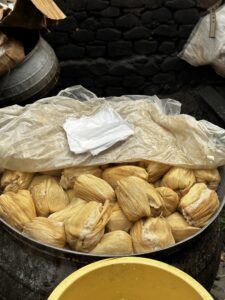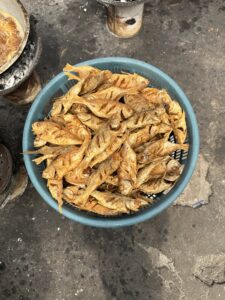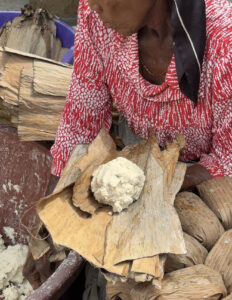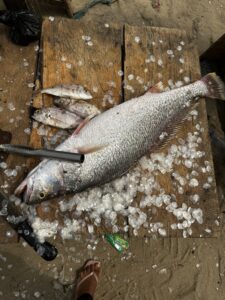Bibiana
April 8, 2024
Food

Bibiana
April 8, 2024
Food
Jamestown is one of the oldest districts in Accra, Ghana. It emerged as a community in the 17th century. Originally known as British Accra, Jamestown was the site of the first British settlement in Ghana. Today, Jamestown thrives as a fishing community predominantly inhabited by the Gas people.
However, it continues to be a center of cultural and historical significance in Ghana. Because the area is predominantly inhabited by Ga’s, the Ga language is the most widely spoken.
Numerous sights may be found, such as the fish market, the lighthouse, and the Ussher Fort, which was constructed in the seventeenth century by the Dutch. I had the pleasure of attending the yearly Chale Wote Festival held in Jamestown a few years ago. It is an exhibition of the town’s lovely culture and heritage. There’s food, music, art, dance, exhibitions, and so forth.
I have always been interested in learning about food from other tribes and cultures. I am on a journey to explore food from all the regions in Ghana and then extend it to other African countries.
This prompted me to travel to Accra, where I met up with Chefabbys, another food blogger, to investigate the Jamestown culinary scene, with an emphasis on the fishing community and the preparation of kenkey. We were both new to the area, but fortunately, our driver knew Ga well enough to ask the appropriate questions and help us find the right location.
We were directed into a household. On entering, we were met with the aroma of fresh fish being cleaned and fried, as well as kenkey on fire. For many women in Jamestown, selling kenkey is their primary source of income. The women who lived in this particular household ran separate Kenkey businesses but collaborated on cooking.
Our goal was to observe the production process of Kenkey firsthand and, of course, to give it a try. Even though we were running late and missed the start of the procedure, we were still able to get some data and material on what was being done.



The Ga’s call kenkey komi, and as much as there are different types of kenkey, the most common ones known to most people are the kenkey wrapped in corn husks, which is generally called komi, and the kenkey wrapped in plantain or banana leaves, which is amadaa baa komi.
The kenkey is wrapped in corn husk, which is the most popular type of kenkey in the greater region. The major difference lies in the leaves used in wrapping it, one being corn husk and the other banana or plantain leaves, respectively. It is the same Kenkey mix placed in both.
Ga kenkey is uniquely crafted by partially cooking fermented corn dough, taking it off the fire, and then incorporating raw corn dough and water to form a paste for shaping into the final kenkey ball.
It then goes to mix with the previously cooked dough, and then, ball by ball, the corn husk is craftily wrapped around each and arranged in the final cooking pot, with water. It is then set to fire at a high temperature and cooked for several hours.


On the other hand, amadaa baa k)mi, translated as plantain leaf kenkey, has the same mixture as the Ga kenkey. But it is salted, unlike Fante Kenkey, which is unsalted. It is wrapped in a plantain leaf. This gives it a darker look when cooked and gives it its own unique taste.
Another difference between the Amadaa baa K)mi and Fante kenkey is that Fante kenkey is cooked primarily with steam. But Amadan is cooked with a little water. Amadan baa Komi can generally be found within Makola and James Town, Accra Central, and the indigenous Ga communities.


Our next destination was the Jamestown fish market. I had to find out where all the fish were coming from. More so as an Asante girl, who only sees the sea when I travel. We headed to the Jamestown community area, where we sought permission to enter the fish market. Well, we really didn’t know if we could just enter on our own accord.
The first thing that hit me was the smell of fresh fish. Well, it’s a fish market for a reason. Then loud noise, very loud noise. “ everything for GHC 100, “ Do you need fish”, ‘local language that I could not understand”. We were being pulled in all directions. This is because everyone was trying to sell their market, which was a bit overwhelming for me.
There were different kinds of fish: long, big, small, colorful, etc. It was truly wonderful to see. It was also very dirty. Dirt in the water, dirt at the shore, and dirt in canoes.
I believe I would probably need to go there again to get the full experience. But this is how it went for me on my first visit. The area leading to the market appeared much tidier than when I visited for the Chalewote Festival four years ago. Back then, it was noticeably less well-kept.
Kenkey is usually eaten with hot red pepper: which is a mixture of pepper, onions tomatoes, shito, and Fish or shrimp with some sliced onions. In modern times, people can go as far as adding sardines, eggs, sausage, corn beef, avocado, etc.
Its origins trace back to regions known for their expertise in its production, where traditional methods and ingredients contribute to its distinctive taste.
Our kenkey was served hot with freshly ground pepper, shito (black pepper sauce), lots of onions, and fried fish. I kid you not when I say it is the best kenkey I have eaten, and I still remember the taste to this day. The kenkey sellers can be located in Jamestown near the lighthouse, Mantse Agbonaa, or Hansen Road.
Copyright © 2023 Cheflifestyle by Teabag Creations. All rights reserved.